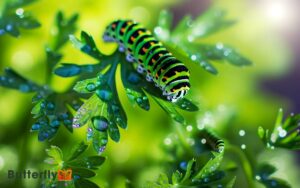Identifying the Yellow and Black Swallowtail Butterfly
The Swallowtail Yellow and Black Butterfly, characterized by its striking black and yellow wings with tail-like extensions on the hindwings, inhabits diverse regions across North America, Europe, Asia, and Africa. Found in environments ranging from tropical rainforests to temperate woodlands, these butterflies thrive in open, nectar-rich areas.
Their life cycle comprises egg, larva, pupa, and adult stages, with larvae feeding on specific host plants. Adults primarily consume nectar from brightly colored flowers.
Known for their role in pollination and intricate mating behaviors, these butterflies exhibit diverse adaptations for survival and reproductive success. Explore their behaviors and conservation needs further.
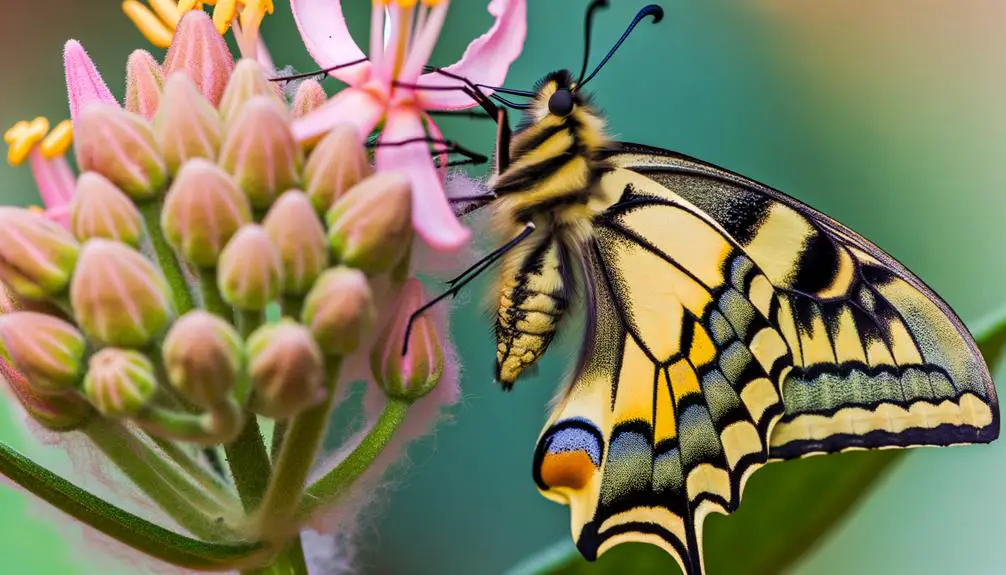
Key Takeaways
- Swallowtail butterflies are large with distinctive yellow and black coloration.
- They have tail-like extensions on their hindwings.
- Found in North America, Europe, Asia, and Africa.
- Adults feed on nectar from flowers like milkweed and lantana.
Identification and Appearance
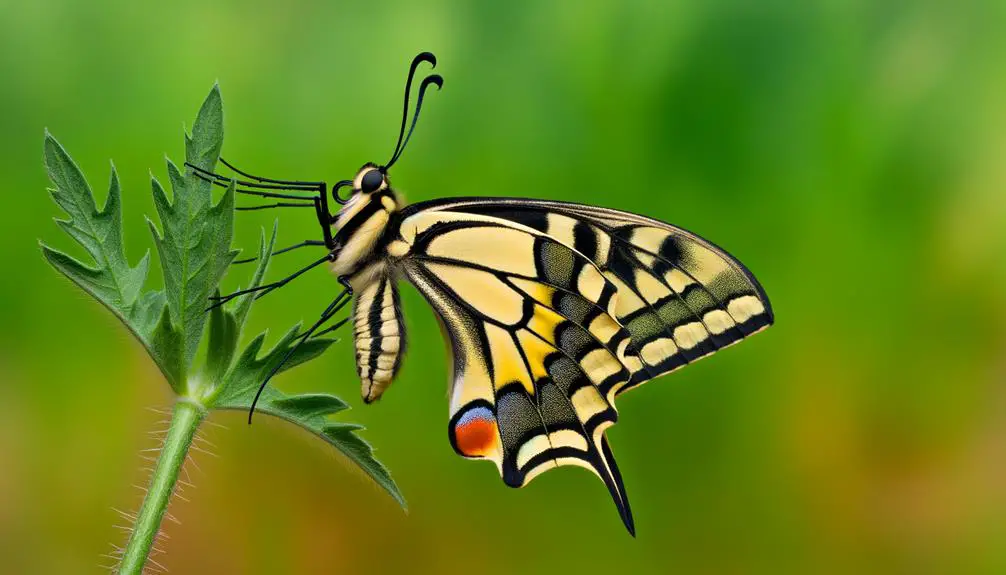
The Swallowtail Butterfly, belonging to the family Papilionidae, is characterized by its large size, distinctive tail-like extensions on the hindwings, and vibrant coloration that often includes a combination of black, yellow, and blue hues.
These morphological features not only aid in species identification but also play an essential role in their survival strategies, such as mimicry and predator avoidance.
The forewings are typically broad and rounded, while the hindwings bear the eponymous 'swallow tails,' which can vary in length and shape among species.
The intricate patterning and iridescence of their scales contribute to their visual allure.
Additionally, sexual dimorphism is evident, with males generally exhibiting more vivid coloration compared to females, a trait likely linked to mating behaviors.
Geographic Distribution
Spanning across various continents, Swallowtail Butterflies inhabit diverse ecosystems ranging from tropical rainforests to temperate woodlands. These Lepidoptera are mainly found in North America, Europe, Asia, and Africa, exhibiting remarkable adaptability to different climatic conditions.
In North America, species such as Papilio glaucus are widespread, while Papilio machaon is prevalent in Europe and Asia. African regions host the Papilio demodocus, which thrives in both savannas and forests.
Swallowtails are generally seen at altitudes varying from sea level to mountainous regions, reflecting their ecological versatility. The butterflies' distribution is influenced by the availability of host plants for larval development and nectar sources for adults, underscoring the intricate relationship between these insects and their environment.
Natural Habitat
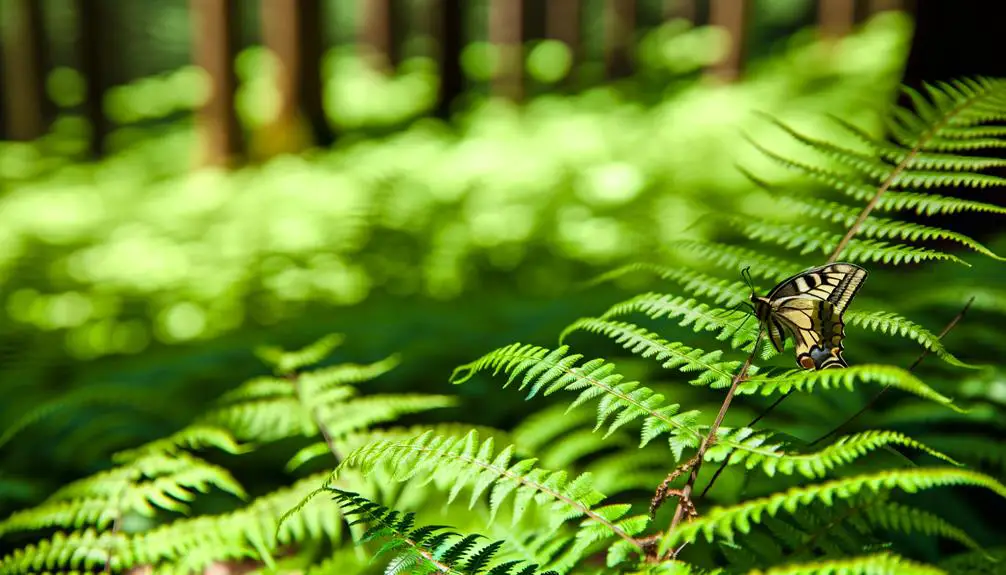
Swallowtail butterflies exhibit a preference for a variety of habitats, including tropical rainforests, temperate woodlands, and grasslands, which support their life cycle requirements.
These environments provide essential resources such as nectar from flowering plants and host plants for their larvae.
Their geographic distribution reflects this adaptability, spanning continents and climatic zones, from North America to Southeast Asia.
Preferred Environments
Thriving in diverse ecosystems, swallowtail butterflies are mainly found in temperate and tropical regions, where they prefer open, sunny environments rich in floral resources.
These vibrant habitats, including meadows, gardens, forest edges, and riverbanks, provide essential nectar sources and host plants for larvae.
Ideal conditions feature abundant sunlight, which facilitates thermoregulation and enhances their activity levels.
Swallowtails are particularly attracted to areas with a variety of flowering plants, such as milkweed, thistles, and clover, which offer ample nectar.
Additionally, they frequent muddy puddles for essential minerals, a behavior known as puddling.
Their presence in these environments underscores the importance of biodiversity, as they rely on a delicate balance of flora and fauna to sustain their life cycle and ecological roles.
Geographic Distribution
The geographic distribution of swallowtail butterflies encompasses a wide range of habitats across North America, Europe, Asia, and parts of Africa, characterized by specific climatic and ecological conditions conducive to their survival.
These areas are distinguished by the following features:
- Temperate Forests: Rich in plant diversity, providing nectar sources and larval host plants.
- Mountain Ranges: Offering varied microclimates that support different swallowtail species.
- Grasslands and Meadows: Abundant in flowering plants essential for adult nourishment.
- Riparian Zones: Moist environments near rivers and streams that facilitate larval development and adult hydration.
These regions collectively provide the necessary resources for the swallowtail's life cycle, including feeding, mating, and larval growth stages, ensuring the species' persistence and proliferation.
Life Cycle Stages
Characterized by distinct phases, the life cycle of a swallowtail butterfly encompasses the egg, larval, pupal, and adult stages.
Initially, eggs are laid on host plants, often selected for their suitability to support larvae. Upon hatching, larvae (caterpillars) emerge, undergoing multiple molts known as instars.
These instars facilitate growth and development, culminating in the formation of a chrysalis during the pupal stage. Within the chrysalis, profound metamorphosis occurs, transforming the larva into an adult butterfly.
The final adult stage, marked by vibrant yellow and black wing patterns, is dedicated to reproduction and dispersal.
This cyclical process guarantees the continuation of the species and highlights the intricate adaptations evolved by the swallowtail butterfly to thrive in diverse environments.
Feeding Habits
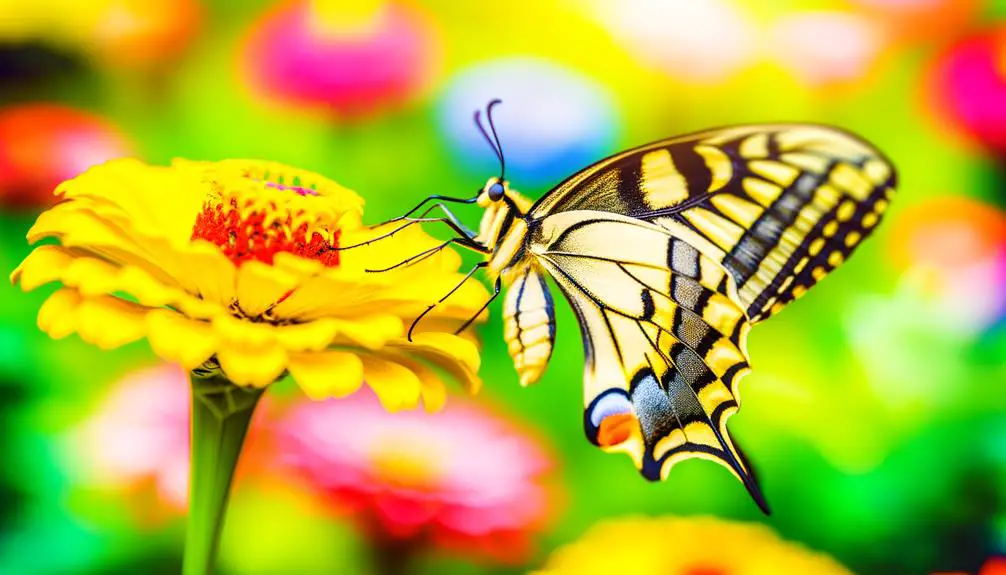
The feeding habits of the Swallowtail butterfly are characterized by their preference for specific nectar sources such as milkweed, lantana, and honeysuckle.
Larval stages exhibit selective feeding on host plants including members of the Apiaceae and Rutaceae families.
Observations indicate that adult Swallowtails primarily feed during daylight hours, with peak activity observed in the morning and late afternoon.
Preferred Nectar Sources
Swallowtail butterflies exhibit a preference for nectar from a variety of flowering plants, including milkweed, thistle, and lantana. Their feeding habits are critical for their survival and reproduction, as nectar provides essential nutrients.
Detailed observations have shown that these butterflies are particularly attracted to:
- Milkweed (Asclepias spp.): Renowned for its abundant nectar, milkweed offers a high-energy food source.
- Thistle (Cirsium spp.): The deep tubular flowers of thistle make it an ideal nectar source for the long proboscis of Swallowtail butterflies.
- Lantana (Lantana camara): This plant provides continuous blooms, ensuring a reliable supply of nectar.
- Butterfly Bush (Buddleja davidii): Known for its dense, fragrant flower clusters, it attracts a variety of nectar-feeding insects, including Swallowtails.
Such preferences highlight the intricate relationship between Swallowtail butterflies and their floral environment.
Larval Host Plants
While adult Swallowtail butterflies rely on nectar from various flowering plants, their larvae exhibit specialized feeding habits, depending on specific host plants.
These caterpillars, or larvae, are oligophagous, meaning they feed on a limited range of plant species.
For instance, the Eastern Black Swallowtail (Papilio polyxenes) primarily utilizes members of the Apiaceae family, such as parsley, dill, and fennel, as their primary host plants.
Similarly, the Western Tiger Swallowtail (Papilio rutulus) favors plants in the Salicaceae family, like willows and cottonwoods.
This specificity in larval host plant selection guarantees ideal nutritional benefits and enhances larval survival rates.
Furthermore, these feeding preferences greatly influence the geographical distribution and habitat selection of Swallowtail species.
Feeding Time Patterns
Adult Swallowtail butterflies exhibit diurnal feeding patterns, actively seeking nectar from flowers during daylight hours when their preferred floral resources are most abundant and accessible.
These butterflies demonstrate a keen preference for specific nectar sources, employing their proboscis to extract essential sustenance.
Key observations include:
- Peak Activity Periods: Swallowtails are most active in mid-morning and early afternoon, coinciding with ideal nectar flow from many floral species.
- Floral Preferences: Commonly visited flowers include milkweed, thistles, and phlox, which provide high-energy nectar.
- Feeding Duration: Each feeding session typically spans several minutes, allowing for sufficient nectar intake.
- Resource Competition: Swallowtails often share feeding sites with other pollinators, necessitating efficient and rapid feeding strategies to maximize nutrient acquisition.
These patterns guarantee that Swallowtails maintain their energy levels for survival and reproduction.
Role in Pollination
Despite their striking appearance, swallowtail butterflies play a crucial role in pollination by transferring pollen between flowers as they feed on nectar.
Their elongated proboscis allows them to access deep floral nectaries, ensuring effective pollen transfer.
These Lepidoptera exhibit a preference for bright, fragrant flowers, including species such as milkweed and phlox, which thrive in open fields and gardens.
Their activity not only facilitates plant reproduction but also contributes to the biodiversity and health of ecosystems.
Observations indicate that swallowtails are particularly effective pollinators due to their frequent and diverse floral visits.
Their intricate interactions with both flora and the environment underscore the importance of conserving these visually enchanting yet ecologically significant insects.
Mating Behaviors
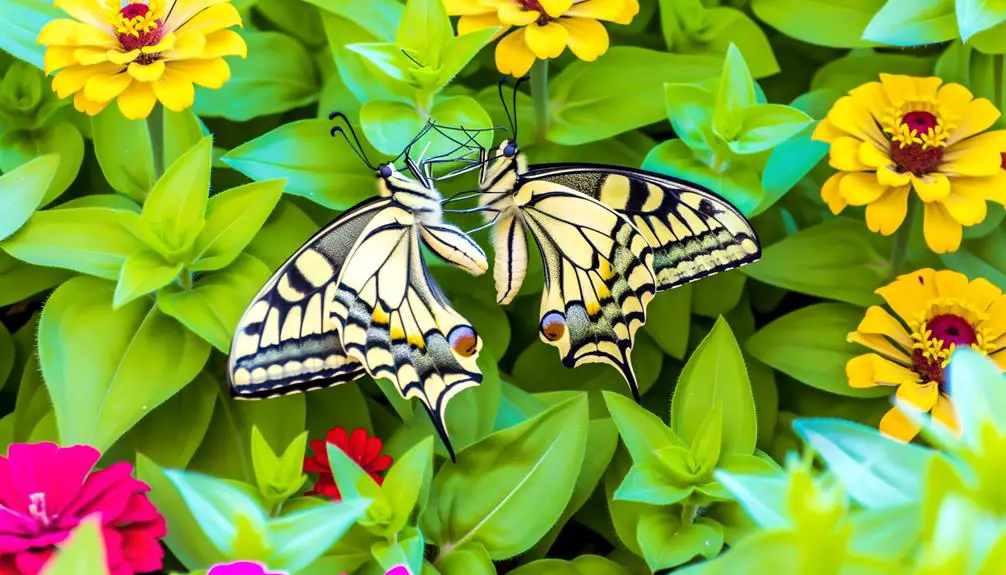
Swallowtail butterflies exhibit a range of intricate mating behaviors that are essential for their reproductive success and species continuation. These behaviors are meticulously orchestrated to guarantee effective mate selection and copulation.
Key mating behaviors include:
- Territorial Displays: Males establish and defend territories to attract females, engaging in aerial displays to deter rivals.
- Chemical Signaling: Pheromones play a significant role in attracting potential mates, with males releasing specific chemicals to entice females.
- Courtship Flights: Elaborate flight patterns are performed by males to demonstrate fitness and suitability to females.
- Mating Chains: In some species, multiple males may form chains, following a single female, increasing the chances of successful mating.
These behaviors underscore the complexity of their mating systems, guaranteeing genetic diversity and population stability.
Predators and Defense
Predation pressures on swallowtail butterflies have driven the evolution of a diverse array of defense mechanisms, essential for their survival across various life stages.
Caterpillars exhibit cryptic coloration, resembling bird droppings, to evade visual predators. Additionally, many swallowtail larvae possess osmeteria, eversible scent glands that release foul-smelling chemicals to deter threats.
Adult butterflies employ mimicry and aposematism; their striking yellow and black patterns often mimic toxic species, dissuading predators through deceptive signaling. Quick, erratic flight patterns further enhance evasion.
These multifaceted strategies underscore the swallowtails' adaptability in the face of avian, reptilian, and insect predators. The evolutionary arms race between predators and prey continuously shapes their intricate defense systems, fostering resilience and sustaining their ecological niche.
Conservation Status
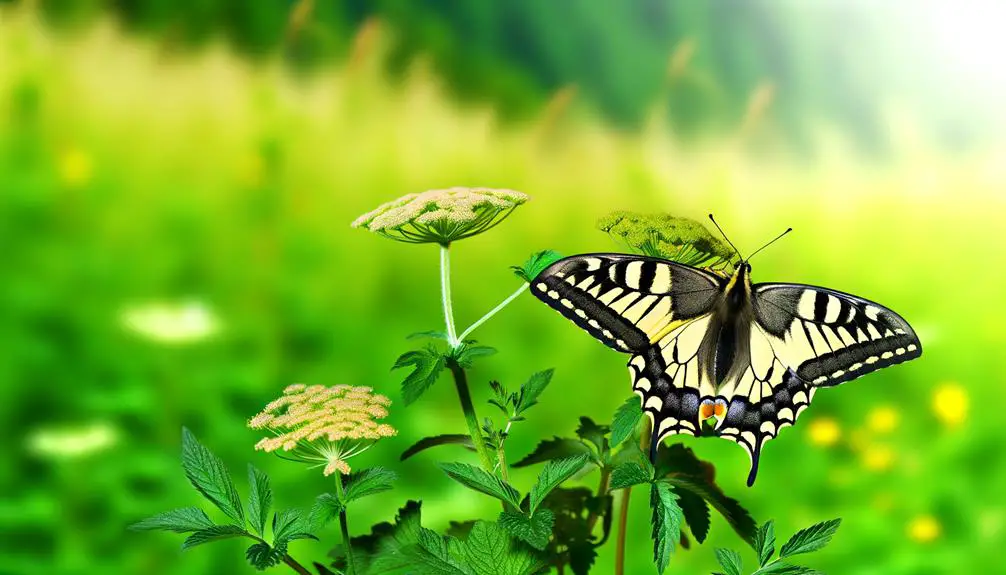
Understanding the intricate defense mechanisms of swallowtail butterflies is essential, yet their conservation status reveals additional challenges impacting their survival.
Various factors contribute to the decline of these vibrant insects, necessitating immediate attention. Key threats include:
- Habitat Loss: Rapid urbanization and deforestation severely diminish the natural habitats of swallowtails.
- Climate Change: Alterations in temperature and weather patterns disrupt their breeding cycles and migratory routes.
- Pesticide Use: Agricultural chemicals harm both larvae and adult butterflies, reducing their populations.
- Invasive Species: Non-native plants and predators outcompete and prey on swallowtails, disrupting their ecological balance.
Efforts to mitigate these threats are vital for the sustainable preservation of swallowtail butterfly populations.
Conservation initiatives must be scientifically informed and strategically implemented.
Fun Facts and Trivia
Swallowtail butterflies are renowned for their distinctive color patterns, which often feature iridescent scales and intricate designs.
They inhabit a diverse range of environments from tropical rainforests to temperate gardens, showcasing remarkable adaptability.
Additionally, their lifecycle, which includes unique behaviors such as mimicry and rapid flight, underscores their evolutionary success.
Unique Color Patterns
The diverse and intricate color patterns of swallowtail butterflies serve multiple ecological functions, including camouflage, mate attraction, and predator deterrence. These patterns are not just aesthetically pleasing but are also essential for their survival and reproductive success.
Here are some key features:
- Mimicry: Some species exhibit Batesian mimicry, where harmless butterflies mimic the warning coloration of toxic species.
- Eyespots: The presence of eyespot patterns on the wings can startle or mislead predators, directing attacks away from critical body parts.
- Sexual Dimorphism: Male and female swallowtails often display different color patterns, aiding in mate recognition and selection.
- Seasonal Variation: Certain species exhibit seasonal polyphenism, where the color patterns change between generations to match seasonal environments.
These attributes highlight the remarkable adaptability and survival strategies of swallowtail butterflies.
Habitat and Range
Widely distributed across various continents, swallowtail butterflies inhabit a range of environments from tropical rainforests to temperate woodlands and even arid deserts.
These butterflies exhibit remarkable adaptability, thriving in diverse ecological niches. In North America, the Eastern Tiger Swallowtail is a common sight in deciduous forests and urban gardens, while the scarce Swallowtail can be found in European meadows and riverbanks.
Tropical species like the Blue Swallowtail favor lush, dense rainforests in South America. Curiously, some species are altitudinal migrants, moving to higher elevations during warmer months.
Their widespread presence underscores their ecological versatility and resilience, making them a fascinating subject for lepidopterists and nature enthusiasts alike. This adaptability guarantees their continued survival across various climates.
Lifecycle and Behavior
Equipped with an intricate lifecycle, these butterflies undergo complete metamorphosis, encompassing four distinct stages: egg, larva (caterpillar), pupa (chrysalis), and adult. Observing these stages reveals fascinating behaviors and developmental milestones.
- Egg Stage: Female swallowtails lay their spherical eggs on host plants, ensuring the emerging larvae have immediate access to food.
- Larval Stage: The caterpillar, often displaying vibrant colors and unique markings, consumes vast quantities of foliage to fuel its rapid growth.
- Pupal Stage: Within the chrysalis, the caterpillar undergoes a remarkable transformation, reorganizing its structure to become a butterfly.
- Adult Stage: Once emerged, the adult butterfly's primary focus shifts to feeding on nectar and seeking mates to propagate the species.
The lifecycle highlights nature's intricate design and adaptability.
Conclusion
The swallowtail yellow and black butterfly, a marvel of nature’s artistry, thrives through its intricate life cycle and diverse habitats. The swallowtail yellow and black butterfly undergoes a fascinating transformation, from egg to caterpillar, then chrysalis, before emerging in its full glory. This butterfly with black wings and vibrant yellow markings can be found fluttering gracefully in gardens, meadows, and forests. Its striking appearance not only serves as a defense mechanism against predators but also enhances the beauty of its natural surroundings.
Its distinctive appearance and adaptive behaviors underscore the delicate balance within ecosystems.
From its vibrant metamorphosis to its strategic defenses against predators, this butterfly exemplifies the interplay of survival and beauty.
Conservation efforts remain essential to preserving such species, ensuring that these winged gems continue to flutter through the tapestry of biodiversity.



